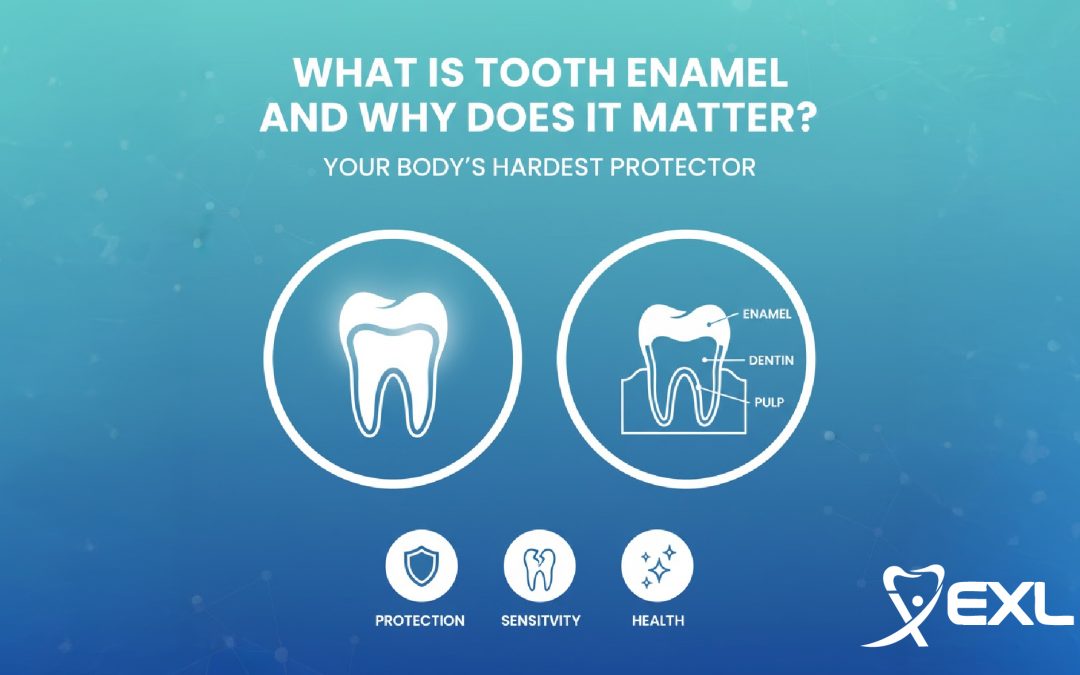You know that shiny, smooth layer on your teeth when you smile? That’s tooth enamel. Most of us don’t even think about it… until something starts to feel off.
Think of enamel as your teeth’s personal armor. It’s a thin, super-strong shell wrapped around each tooth, quietly taking hits every single day. Hot drinks, cold snacks, random chewing, midnight food raids, enamel handles it all without complaining.
But here’s the deal: once enamel wears away, it’s gone. There’s no “refresh” button. Unlike skin, your body can’t grow back. That’s why it’s worth actually understanding what it is and how to protect it, not just nodding through your dentist’s explanations.
So… What Exactly Is Tooth Enamel?
Picture this: enamel is literally the hardest substance in your entire body. Tougher than bone. It’s loaded with minerals, which is why it holds up when you go from piping hot coffee to ice-cold water without your teeth cracking in protest.
But here’s the tricky part — enamel doesn’t have living cells. So if it chips, cracks, or wears down, it doesn’t heal on its own. That’s why catching issues early makes such a difference. A quick visit to the Best Dentist in Gurgaon can spot those early warning signs before they turn into sharp “ouch” moments every time you sip something cold.
Why Enamel Matters More Than You Think
Enamel isn’t just there to make your teeth look bright and shiny. It’s your teeth’s shield. It blocks bacteria, plaque, and acids from reaching the softer, more sensitive parts underneath.
When that shield starts thinning, problems don’t take long to show up. At first, it’s usually little things like:
- A quick sting when you eat or drink something cold or sweet
- A dull yellowish tint peeking through (that’s dentin showing)
- Rough edges that weren’t there before
- Cavities appearing more often than usual
A lot of people walk into a Dental Clinic in DLF Phase 4 thinking it’s “just a bit of sensitivity,” and then find out enamel erosion has been building up quietly in the background. Even biting into an apple can start to feel sharp and uncomfortable.
What Wears Down Enamel
Enamel doesn’t suddenly vanish. It’s usually your everyday habits that chip away at it over time. A few of the main culprits are:
- Acidic foods and drinks — Sodas, citrus fruits, vinegar, energy drinks. All that acid slowly softens enamel.
- Brushing too hard — It’s a thing. Scrubbing like you’re cleaning a bathroom tile actually wears enamel down.
- Teeth grinding — Especially while sleeping. That constant pressure takes a toll.
- Dry mouth — Saliva is like your natural mouth defense. Less saliva means acids hang around longer.
- Acid reflux (GERD) — Stomach acid creeping into your mouth isn’t enamel’s best friend.
Subtle Signs People Often Miss
Enamel erosion usually gives little hints before it gets serious. Most people just overlook them. Watch out for things like:
- Sudden sensitivity while eating or drinking
- Teeth looking slightly more yellow or dull than usual
- Edges that feel smoother or more rounded
- Tiny chips or cracks that you don’t remember causing
If any of this sounds familiar, it’s better to get it checked early. A quick visit for general dentistry in Gurgaon can stop a small issue from turning into a big, painful one.
Wrapping It Up
Enamel is one of those quiet protectors — always working, rarely noticed. You don’t really think about it… until something feels weird. Maybe it’s that sharp zing from cold water or a yellow patch that suddenly caught your eye.
Once enamel starts to wear down, there’s no miracle fix. The smart move is to stay on top of it, not wait for trouble to show up. Think of it like looking after your car: regular tune-ups are way cheaper and easier than dealing with a breakdown.
A few smart daily habits plus routine dental checkups go a long way. And if you’ve spotted even the tiniest signs of enamel wear, don’t put it off. Drop by EXL Dentist, a trusted Dental Clinic in DLF Phase 4, get things checked out, and handle it early. A little care now can save you a lot of pain — and money — later.

